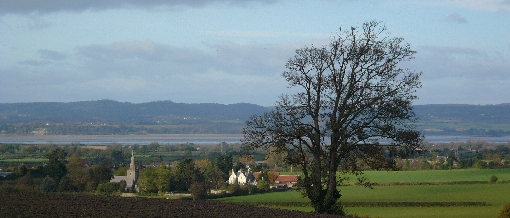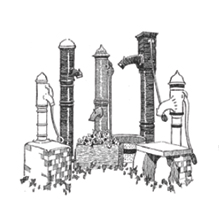Aust Parish
Aust Parish comprises the villages of Aust, Littleton-on-Severn and Elberton. The Village of Aust is on a promontory of land with a cliff containing a rich bed of fossils and gypsum on the banks of the River Severn. The area was once surrounded by marshland that flooded during hightides until a seawall and bank were constructed, together with drainage rhines. The tidal range on the Bristol Channel and River Severn is second only to the Bay of Fundy in Nova Scotia.
Aust was a tithing within the parish of Henbury until it became a parish in its own right in 1884. Since Roman times, Aust has been a ferry crossing point, known as Old Passage Ferry after the formation of a New Passage Ferry three miles south at Redwick in 1630. Old Passage ceased to operate after a major accident in 1855 but reopened in 1924, becoming a car ferry in1931. This operated until the opening of the M4 (now M48) toll bridge by Her Majesty Queen Elizabeth II in 1966.
There is an active church dating from the 13th century built on the site where it is said that St Augustine met the Welsh bishops in AD 597. John Wycliffe the reformer held the living in 1374. A Methodist Chapel was built in 1886 and enlarged in 1997 when, with the Archbishop of Canterbury, a pilgrimage was instituted to commemorate St. Augustine's historic meeting.
A horse and coach carrier business operated to Bristol via Elberton, Olveston and Tockington until a bus service from Bristol was introduced from Bristol in 1931 for passengers using the newly refitted ferry. An ancient Inn, The Boar's Head, exists; it became well known to car travellers during the 1950s and 60s for fresh-caught Severn salmon sandwiches.
The Village of Littleton-on-Severn is inland from the River Severn on the fringe of what was once marshland. The church which possibly dates from Norman times was under the control of Malmesbury Abbey, the Abbot having a summer residence in the village. In the 18th century most of the village farmers were Quakers, at which time they won a court case against a new village vicar for non-payment of church tithes. A stone commemorative plaque still exists recording this judgment.
Littleton Pill was in continuous use by workboats, the Matilda being the last of these; it ceased working in the early 1930s and was left to decay on the bank of the Pill. For a period between the 1960s and 80s, pleasure boats moored there. Adjacent to the foreshore and its flood prevention bank, the brickworks were built in the mid 19th century. It closed in the 1950s and the buildings were used to manufacture pleasure boats until the early 1970s, at which time a complete demolition of the site took place, enabling the 1980 construction of offices and manufacturing facilities for ElectroTech. The redundant clay pits became a private fishing lake. The area is known as ‘Whale Wharf' as a result of a whale becoming stranded there in January 1885. It was pulled to the bank by a steam traction engine and became a visitor attraction, the whale's mouth being propped open to allow photographs of men standing in it. Close to this spot in February 1954 a Bristol Britannia passenger aircraft on a demonstration flight from Filton crash-landed on the tidal mudflats. A major logistical exercise was mounted by the Bristol Aeroplane Company to salvage the aircraft during snow conditions.
A National School was built in 1858 for 36 children and enlarged in 1897 by joining together an adjacent Methodist Chapel that had been built in 1837. The school closed in the mid 1960s and the building became the Littleton Village Hall. At the village boundary with Elberton, a Bristol Water Company treatment works is situated, extracting water from the Sharpness Canal and processing it into the community water supply. No shops now exist in the village but the ancient White Hart Inn remains ever popular.
Littleton events and functions are notified to villagers by a calendar at the beginning of the year and a monthly community newsletter. Go to the Littleton Village Hall page to see the latest monthly newsletter.
The Village of Elberton is situated some two miles inland from the River Severn surrounded by farmland. The remains of an Iron Age/ Roman camp still exist at its eastern side.
On Elberton Green in 1654, the Quakers John Audland and John Camm held a large first meeting and Elberton was the birthplace of Joseph Sturge the 6th, a Quaker who came to national prominence during the 19th century for his opposition to Slavery, the Corn Laws and the Crimean War. He purchased two plantations in Montserrat to demonstrate that slavery was unnecessary. These plantations were named Elberton and Olveston. The church of St John is of the early English style with an embattled tower and stone needle spire. During the 18th and 19th centuries the church was attached to Olveston church; it was thoroughly restored in 1858 and the spire again in year 2000. Since 1836 children have been sent to school at Olveston when an Olveston and Elberton National School was built.
A large worked-out quarry is in-filled with refuse and capped with clay, such that the resulting methane gas is harnessed to produce electricity for the National Grid. During the major expansion of the quarry in the 1960s, seven dwellings including the vicarage were demolished and also a road with its religious ‘Priest Pool'. During the last quarter of the 20th century, some eleven houses were erected or converted from redundant farm buildings.

